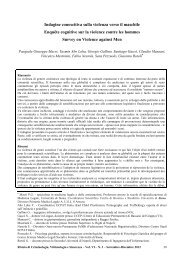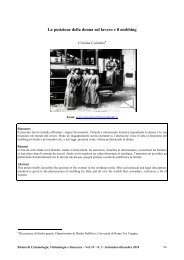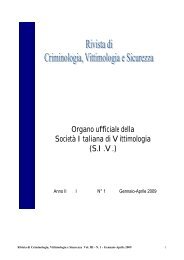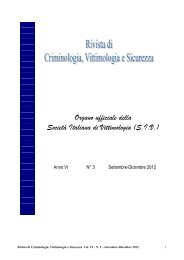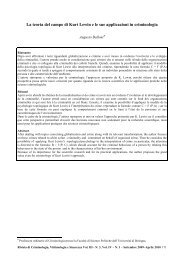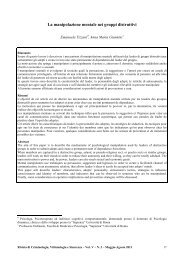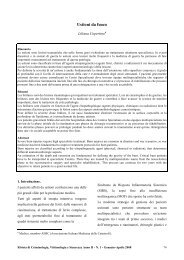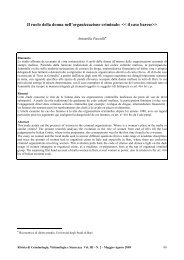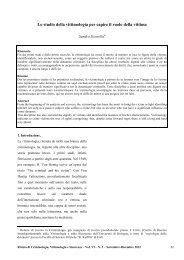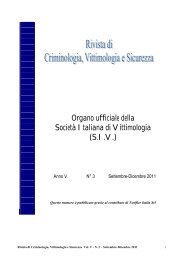Anno 2, Numero 3, Settembre-Dicembre 2008 - Vittimologia
Anno 2, Numero 3, Settembre-Dicembre 2008 - Vittimologia
Anno 2, Numero 3, Settembre-Dicembre 2008 - Vittimologia
You also want an ePaper? Increase the reach of your titles
YUMPU automatically turns print PDFs into web optimized ePapers that Google loves.
This article speaks about the comparison between two different crimes (kidnapping) which happened in Argentina; they are<br />
similar because the crime’s feature and mass media manipulation, but they differ in stretch and political context.<br />
These two kidnappings caused the hostages’ death: the first, the Ayerza case, happened in 1932-1933, the second happened<br />
in 2004.<br />
The two episodes are similar because: 1) the victim was a young University student; 2) he comes from a family that had an<br />
high social position; 3) Right Wing political ideals; 4) mass media presence during the time; 5) the general demand for more<br />
authority repression; 6) a plan about a criminal jurisdiction reform; 7) the crimes’ perpetrators were punished; 8) the<br />
coincidence between crimes and economic crisis.<br />
The first crime, Ayerza, is about a kidnapping which happened on the 25 of October 1933. The body was found on the 21 of<br />
February 1933. In Argentina at the time there was a complex economic crisis and also a military dictatorship. The victim<br />
was a young University student, his family had an high social position and he was a member of the local fascist movement<br />
(Legión Cívica).<br />
The Conservative Government was accused of complicity, the people asked for more severe punishment, Legión Cívica’s<br />
militants asserted their selves, revenge was promised and the death penalty was requested. Two months later, criminals, that<br />
belonged to an Italian gang (Galiffi’s Gang), were arrested.<br />
The kidnappers’ political identity was known, so the victim’s political organization exalted nationalism and delivered<br />
speeches about foreign criminals.<br />
The executive power reacted by suggesting repressive reforms in Penal Code, but it never passed on because the Senate did<br />
not approved it.<br />
In 2004, the social and historical context and the consequences were different because of the “victim/hero phenomenon”.<br />
Besides, the political situation was dissimilar because there were free and fair elections.<br />
Mass media attention shifted when the body was found from the victim to his father who assumed the major role of the new<br />
victim.<br />
Father and son did not belong to a political party, this is an important difference in comparison with the other event. The<br />
father surrounded himself with consultants linked to the dictatorship in 1976-1983, or to the corrupt political control in<br />
1989-1999.<br />
At the beginning, the victim/hero had an ample support, but little by little the attention stopped because mass media’s<br />
directors refused to help him; the victim/hero, also, made a lot of political mistakes.<br />
The political power did not present any reforms in Penal Code. The victim’s father suggested reforms to the Congress<br />
worked out by his collaborators. He received proposals by politicians to become a candidate, but during the time he<br />
disappeared.<br />
So, the victim/hero “construction” may destabilize democratic state institutions by introducing values contrary to solidarity,<br />
equality, freedom, democracy.<br />
The democratic institutions have lost their faculties of reaction and defence and they resigned their self to victim/hero’s<br />
threats. It is a new phenomenon that cause problems in criminal jurisdiction and in criminal policy, but it sacrifices victim’s<br />
mental health.<br />
Summarizing:<br />
- an handling made by victims through their role of heroes is increasing;<br />
- this handling could put in danger the State;<br />
- the communication causes a momentary relief for the victim, but it could provoke a new victimization.<br />
1. La política actual y la delincuencia urbana.<br />
(¿A alguien le interesa prevenir la delincuencia<br />
urbana?)<br />
Existe un preocupante fenómeno de delincuencia<br />
urbana en todo el mundo. La vida se ha vuelto<br />
urbana, la población mundial tiende a<br />
concentrarse en ciudades y, por ende, la<br />
criminalidad también. Pero el hecho de la<br />
delincuencia urbana es proyectado a la población<br />
a través de la comunicación masiva, que construye<br />
la realidad de la delincuencia urbana (proyección<br />
mediática del hecho). Por último hay una<br />
respuesta política al hecho y a su proyección.<br />
Teóricamente puede distinguirse la respuesta<br />
política al hecho (medidas preventivas y<br />
represivas, servicio de seguridad, etc.) de la<br />
respuesta política a la proyección (discurso<br />
político de seguridad) pero en la práctica no son<br />
independientes e incluso se confunden de modo<br />
inextricable: los legisladores, las agencias<br />
ejecutivas y los responsables políticos de éstas e<br />
incluso los poderes ejecutivos, responden al hecho<br />
Rivista di Criminologia, <strong>Vittimologia</strong> e Sicurezza Vol. II - N. 3 - <strong>Settembre</strong>-<strong>Dicembre</strong> <strong>2008</strong> 9



